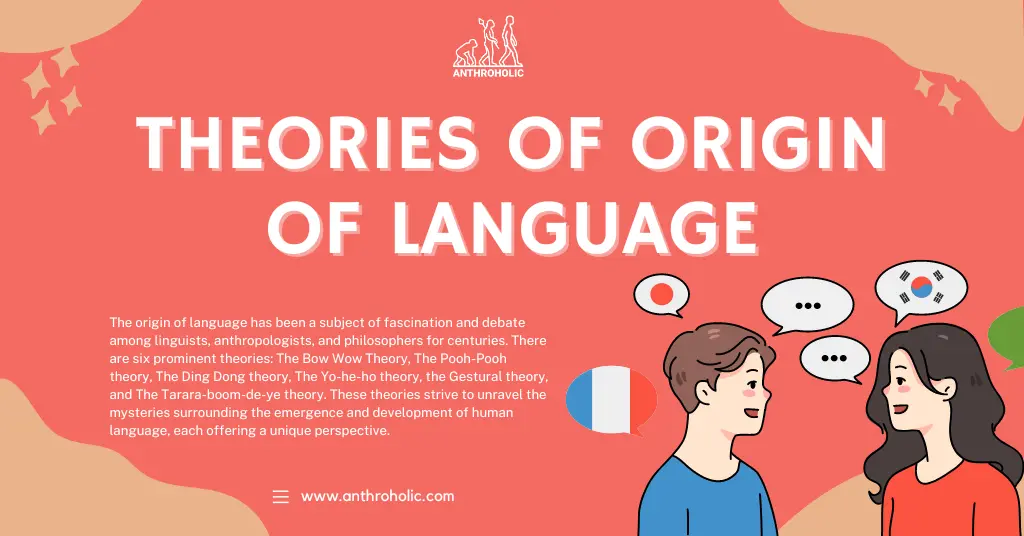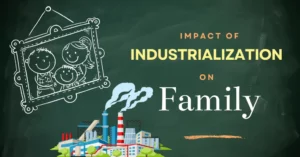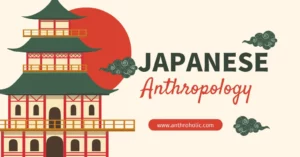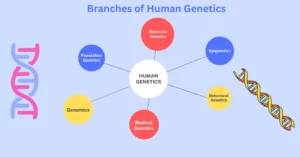AI Answer Evaluation Platform Live Now. Try Free Answer Evaluation Now
Theories of Origin of Language
The origin of language has been a subject of fascination and debate among linguists, anthropologists, and philosophers for centuries. There are six prominent theories of origin of language: The Bow Wow Theory, The Pooh-Pooh theory, The Ding Dong theory, The Yo-he-ho theory, the Gestural theory, and The Tarara-boom-de-ye theory. These theories strive to unravel the mysteries surrounding the emergence and development of human language, each offering a unique perspective.

The Bow Wow Theory
Proposed in the 19th century by Max Müller, the Bow Wow Theory suggests that language originated from attempts to imitate natural sounds [1]. This theory posits that early humans imitated sounds produced by animals and natural phenomena to communicate.
- Key points:
- Language began as mimicry of natural sounds.
- Words were developed from these sounds.
Despite its innovative ideas, critics argue that the theory fails to account for abstract concepts that cannot be mimicked audibly [2].
The Pooh-Pooh Theory
The Pooh-Pooh theory posits that the origin of language lies in spontaneous human exclamations and interjections caused by pain, surprise, or other strong emotions [3].
- Key points:
- Language emerged from instinctive emotional responses.
- Early words were likely simple expressions of surprise or distress.
Critics of this theory assert that emotional exclamations alone are insufficient to form the basis of a complex language system [4].

The Ding-Dong Theory
The Ding-Dong theory, also proposed by Müller, suggests that language evolved as a response to the resonant qualities of the natural environment. It maintains that our ancestors developed words and sounds that mirror the harmonious or discordant elements of the surrounding world [5].
- Key points:
- Language developed as a reflection of environmental resonance.
- Words were inspired by the harmony or disharmony of natural sounds.
However, the Ding-Dong theory has been criticized for its lack of empirical evidence and its failure to explain languages’ capacity for abstraction and creativity [6].
The Yo-He-Ho Theory
The Yo-He-Ho theory proposes that language originated from the rhythmic sounds and chants produced during communal labor. This theory suggests that language developed as a tool for coordinating collective activities and fostering social cohesion [7].
- Key points:
- Language emerged from communal work rhythms.
- Language facilitated coordination and social cohesion.
Critics note that while this theory might explain the origins of rhythmic and prosodic elements in language, it does not sufficiently explain the development of complex syntax and semantics [8].
The Gestural Theory
The Gestural theory posits that language began as a system of gestures before developing into vocal communication. This theory is supported by research showing a strong correlation between gesture and language in modern humans and other primates [9].
- Key points:
- Language started as a system of gestures.
- The transition from gesture to speech was likely gradual.
This theory is bolstered by evidence from sign languages, which use space and movement in ways analogous to the use of sound in spoken languages[10]. Critics, however, argue that it does not sufficiently explain why speech eventually replaced gesturing in most cultures [11].
The Tarara-boom-de-ye Theory
The Tarara-boom-de-ye theory suggests that language emerged from playful, musical, and rhythmic expressions, often in a social context [12].
- Key points:
- Language began as playful and musical expressions.
- These expressions later developed into more structured language.
This theory has gained support from the observation that musicality is a universal trait in human societies. However, detractors argue that it doesn’t fully explain the emergence of the syntactical and semantic complexity of languages [13].
Table Summary of Theories
| Theory | Proponent | Key Idea | Criticisms |
|---|---|---|---|
| Bow Wow Theory | Max Müller | Language originated from imitation of natural sounds | Does not account for abstract concepts |
| Pooh-Pooh Theory | Not specific | Originated from spontaneous exclamations due to strong emotions | Insufficient to form complex language system |
| Ding-Dong Theory | Max Müller | Language evolved as a response to resonant qualities of the environment | Lack of empirical evidence; does not account for abstract language |
| Yo-He-Ho Theory | Not specific | Originated from rhythmic sounds during communal labor | Doesn’t explain the development of syntax and semantics |
| Gestural Theory | Multiple | Language began as a system of gestures | Doesn’t explain why speech replaced gesturing |
| Tarara-boom-de-ye Theory | Not specific | Emerged from playful, musical expressions | Doesn’t fully explain syntactical and semantic complexity |
Conclusion
The quest for the origins of language has yielded many theories, each with its own merits and shortcomings. While no single theory can fully explain the complex journey from primal sounds to intricate languages, the interdisciplinary nature of this inquiry suggests a multifaceted origin story that incorporates elements from several theories.
References
[1] Müller, M. (1861). Lectures on the Science of Language.
[2] Pinker, S., & Bloom, P. (1990). Natural language and natural selection.
[3] Jespersen, O. (1922). Language: Its Nature, Development and Origin.
[4] Aitchison, J. (1996). The Seeds of Speech: Language Origin and Evolution.
[5] Müller, M. (1870). Lectures on the Science of Language.
[6] Jackendoff, R. (1999). Possible stages in the evolution of the language capacity.
[7] Firth, J.R. (1964). The Tongues of Men and Speech.
[8] Tallerman, M. (2014). Understanding Syntax.
[9] Corballis, M.C. (2010). The Gestural Origin of Language.
[10] Armstrong, D.F., Stokoe, W.C., & Wilcox, S.E. (1995). Gesture and the Nature of Language.
[11] Tomasello, M. (2008). Origins of Human Communication.
[12] Mithen, S. (2005). The Singing Neanderthals: The Origins of Music, Language, Mind, and Body.
[13] Patel, A.D. (2010). Music, Language, and the Brain.




